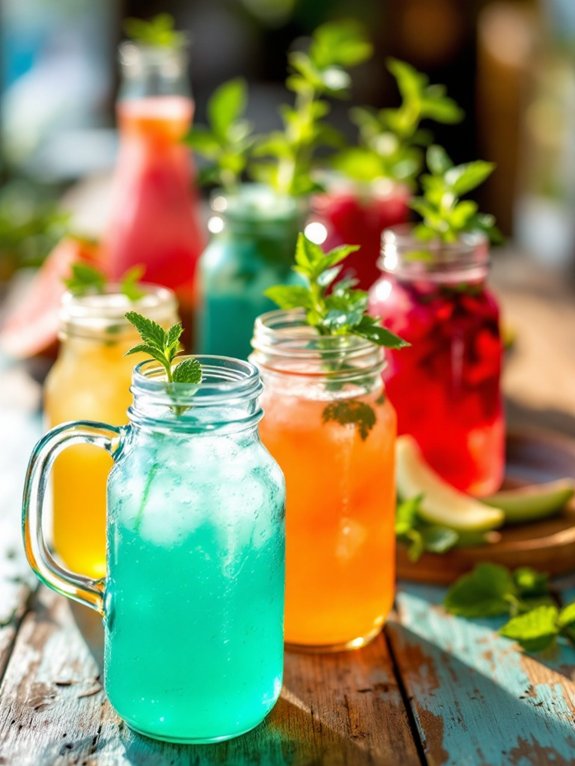You're three fresh ingredients away from becoming the ultimate dip connoisseur! Grab some juicy tomatoes, crunchy onions, and fragrant cilantro, and you'll be well on your way to whipping up the freshest Pico De Gallo salsa this side of the Aztecs. Dice those bad boys up, toss in some jalapeño heat and lime juice zing, and you're golden. This Mexican staple is ridiculously easy to make and packs a flavor punch that'll knock your socks off. Now that you've got the basics down, it's time to take your taco game to the next level…
Quick Facts
- Fresh Pico De Gallo Salsa originates from ancient Aztec civilization, combining fresh ingredients like tomatoes, onions, and peppers.
- Key ingredients include diced Roma tomatoes, onions, fresh cilantro, jalapeño or serrano peppers, and fresh lime juice.
- To prepare, dice ingredients carefully, strain tomatoes, mix in a bowl, and refrigerate for at least 30 minutes to meld flavors.
- This salsa is low in calories, rich in vitamins A and C, and contains fiber, making it a nutritious and guilt-free condiment.
- Serve with tortilla chips, use as a topping for tacos or grilled meats, and consider adding optional ingredients like garlic or cumin for extra flavor.
History
You think Pico de Gallo is just a tasty dip for your tortilla chips? Think again, amigo! This spicy salsa has a rich history that'll make you appreciate it even more. Pico de Gallo's roots go back to the ancient Aztecs, who knew a thing or two about combining fresh ingredients to create bold flavors. One theory suggests it originated in Central America, while another proposes it was born in Mexico, developing alongside dishes like tacos and enchiladas.
Whatever its exact origin, Pico de Gallo's cultural significance is undeniable. It's deeply ingrained in Mexican cuisine and culture, earning the nickname "salsa bandera" due to its colors resembling the Mexican national flag. This salsa played a starring role in ancient Mexican cuisine, particularly during Aztec times. Over time, it adapted to local tastes and preferences, becoming a staple condiment in Mexican and global cuisines. Traditional recipes include diced tomatoes, onions, cilantro, and peppers as the foundation for its fresh flavor. So, next time you scoop up that delicious Pico de Gallo with your tortilla chip, remember the Aztec origins and cultural significance behind this flavorful dip. Your taste buds – and your sense of history – will thank you!
Recipe

Pico de Gallo is a classic Mexican salsa made with fresh, raw ingredients. Its name translates to "pecking of the rooster," which refers to the traditional method of making the salsa by dicing the ingredients with a sharp knife.
To make a delicious Pico de Gallo, it's important to use the freshest ingredients possible. The salsa's flavor and texture rely heavily on the quality of the tomatoes, onions, peppers, cilantro, and lime juice used. Roma tomatoes are the preferred choice for Pico de Gallo because they are meatier with less juice.
- 1 cup diced fresh tomatoes
- 1/2 cup diced onion
- 1/4 cup diced fresh cilantro
- 1-2 diced jalapeño or serrano peppers
- 2 tablespoons freshly squeezed lime juice
- 1 teaspoon salt
- Optional: 1 clove garlic, 1/2 cup diced bell pepper, 1 teaspoon ground cumin
To prepare the Pico de Gallo, start by dicing the tomatoes, onion, cilantro, and peppers. Strain the tomatoes to remove excess juice and combine all the ingredients in a bowl. Stir the mixture well to guarantee everything is fully incorporated.
Next, add the lime juice and salt to the bowl and stir again to combine. Taste the salsa and adjust the seasoning as needed. If the salsa is too spicy, remove some of the pepper seeds. If it's not spicy enough, add more peppers. Cover the bowl with plastic wrap and refrigerate the salsa for at least 30 minutes to allow the flavors to meld together.
When making Pico de Gallo, it's important to handle the ingredients gently to avoid bruising them and making the salsa too watery. Also, be careful not to over-process the ingredients, as this can make the salsa too smooth and lose its chunky texture. Finally, use a slotted spoon to transfer the salsa to a new bowl if it becomes too watery, and avoid freezing the salsa, as it can become mushy and grainy upon thawing.
Final Thoughts
While the nutritional benefits of this tasty salsa are undeniable, let's be real – you're probably not devouring Pico de Gallo by the bucketload because it's a health superfood (although, hey, that's a great bonus). You're in it for the flavor, and who can blame you? But, as it turns out, you're getting a pretty sweet deal on the health benefits front too. This salsa is low in calories, rich in vitamins A and C, and even contains some fiber to help keep you regular. The high water content present in it due to the fresh ingredients promotes digestive health.
Frequently Asked Questions
What Type of Tomatoes Are Best for Making Fresh Pico De Gallo?
You're gonna want to ditch those bland, mushy tomatoes and go for the good stuff – heirloom or Roma tomatoes are your best bet, with their rich flavor and meaty texture, trust us, your taste buds will thank you.
Can I Use Canned Tomatoes Instead of Fresh Tomatoes?
Eighty percent of tomatoes are consumed processed, so you're in good company if you opt for canned! Just know that top-notch canned tomato quality is key to a comparable flavor experience – choose wisely, friend!
How Long Does Fresh Pico De Gallo Typically Last in the Fridge?
You're wondering how long that deliciousness will last in the fridge? Typically, it's 3 days, but follow some simple storage tips and keep an eye out for freshness indicators, like a foul odor, to enjoy it for up to 5 days.
Can I Make Pico De Gallo in a Blender or Food Processor?
You can make pico de gallo in a blender or food processor, but don't expect a blender to nail the chunky salsa consistency – its blender techniques are better suited for smoothies, not salsa.
Is Pico De Gallo Suitable for a Low-Acid Diet or for Canning?
Are you kidding me, low-acid diet and canning? Pico de gallo's a stretch! You'll need low-acid substitutes, like citrus or vinegar, to tweak the pH. Expert canning techniques, and you might just pull it off, freedom-seeker!



